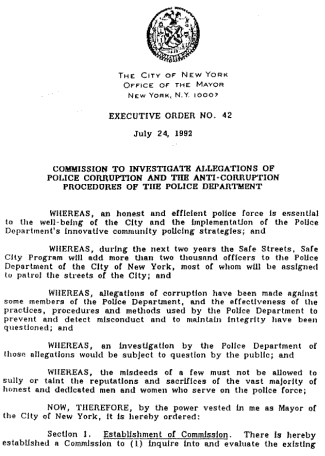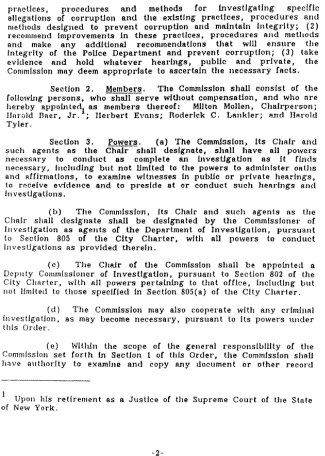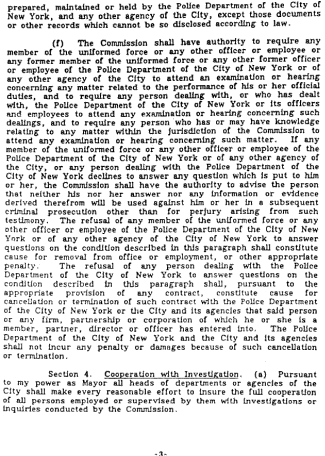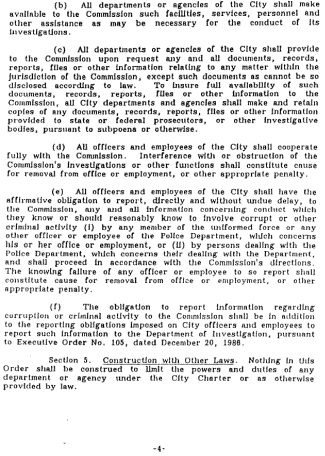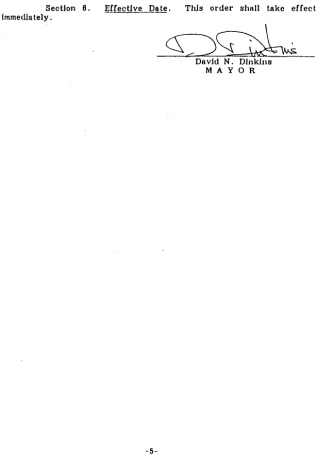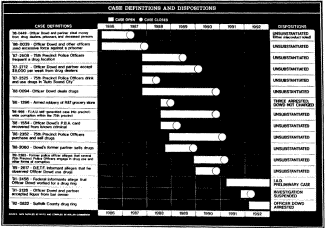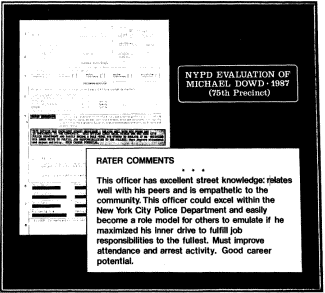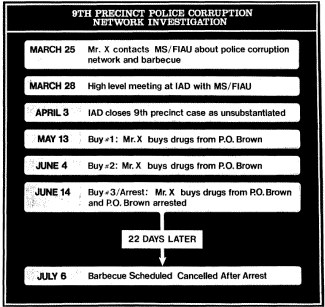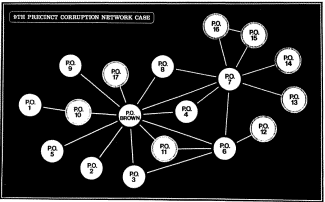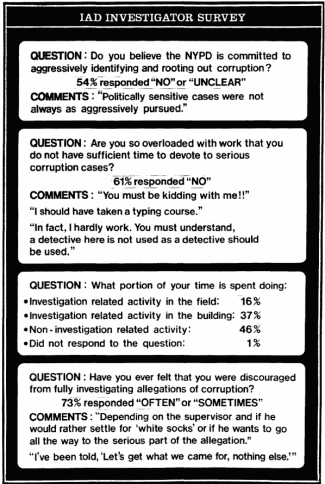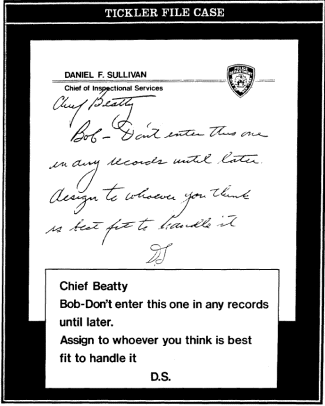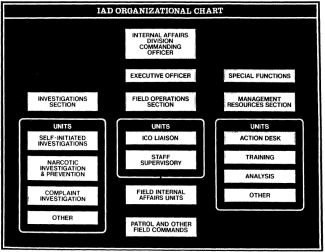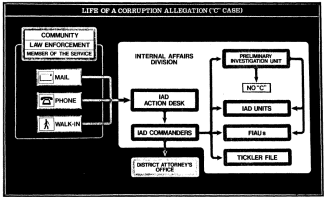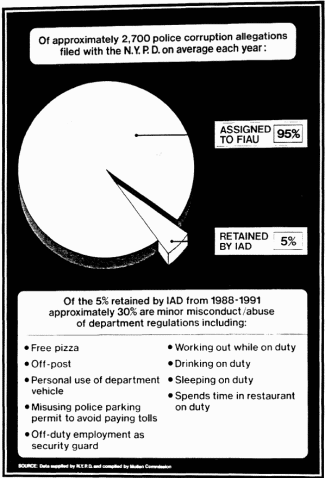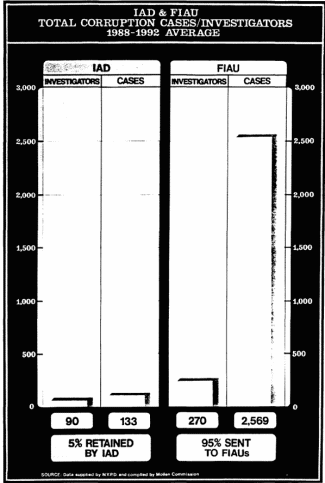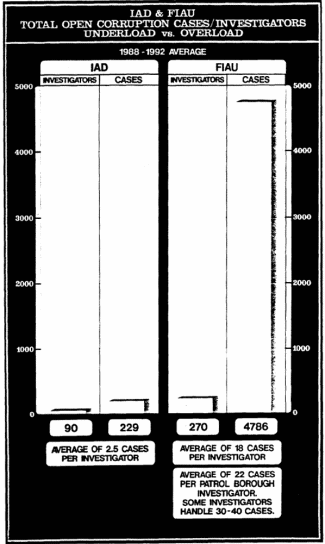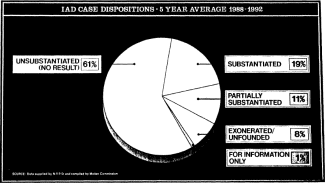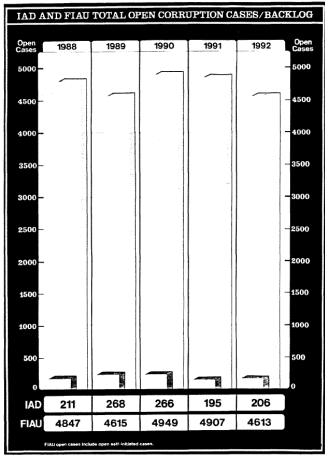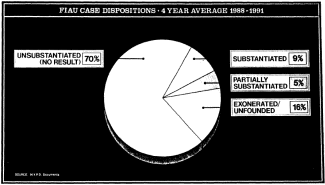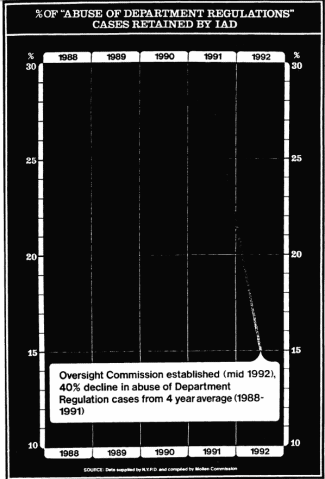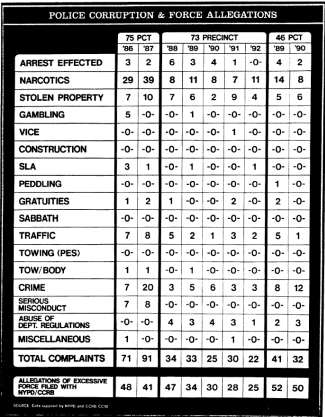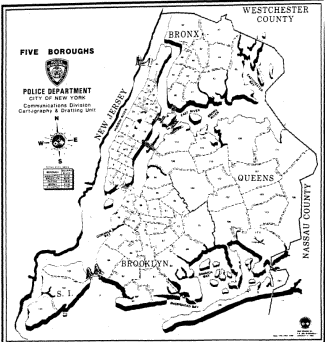CHAPTER FIVE: RECOMMENDATIONS FOR REFORM OF THE DEPARTMENT'S CORRUPTION CONTROL POLICIES AND PROCEDURES
"The People of New York City must know they can count on the members of their Police Department to be as honest as they are brave and able. They must know they can count on the Police Department to track down and drive from our ranks those who violate their oath and break the law."
-- Former Police Commissioner Raymond Kelly, Testimony before the Mollen Commission, October 6, 1993
The Department must remain primarily responsible for successfully policing itself and keeping its own house in order. It must "track down and drive from" its own ranks officers who violate their oath and the law, as former Commissioner Raymond Kelly testified at our public hearings. We believe that this requires a dual-track approach: reform of the Department's internal systems for preventing and uncovering corruption, and an external, independent monitor to insure those systems are successful. The independent monitor is discussed in Chapter Six. Our recommendations for internal reforms are discussed here.
During the tenure of the Commission, the Department has begun to take significant steps to strengthen its corruption controls. The bulk of these reforms, however, has focused on improving and expanding detection and investigative efforts. While such reforms are essential, the Commission believes that the effective control of police corruption must focus on prevention as much as detection; on the root causes and conditions of corruption as well as its symptoms. Police corruption is not a problem that will be solved solely by successful investigations and prosecutions. It is a problem that must be addressed on many fronts and in the daily operation of the Department, including:
• I. Police Culture and Management
o Commitment
o Recruitment and Screening
o Recruit and In-Service Performance Evaluations
o Integrity Training
o Corruption Susceptibility and Police Management
o Police Unions
o Drug Testing
o New York City Residency
• II. Command Accountability
o Supervision
o Enforcement of Command Accountability
• III. Internal Investigations
o Internal Affairs Operations
o Recruitment of Qualified Investigators
o Intelligence-Gathering Operations
o Investigative Approach
o Organizational Structure
o Command Liaisons
o Civil Rights Investigations
• IV. Heightening Deterrence and Sanctions
o Discipline
o Department Advocate's Office
o Disability Pensions
• V. Community Outreach
o Community Policing and Community Outreach
It is these areas that are the focus of our internal reform recommendations. While the Department has begun to adopt and implement a number of these reforms during the tenure of this Commission, our objective is to guarantee their long-term success, and to set forth the full scope of reforms we believe are necessary to combat corruption and the culture that tolerates and protects it.
I. POLICE CULTURE AND MANAGEMENT
Commitment to Integrity
At the core of the Department's corruption control reforms must be an unwavering commitment to insure their success now and in the future. Without such commitment, no anti-corruption system, no matter how well devised, has a chance to succeed. The abysmal state of the Department's corruption controls that we found existed over past years should provide a lasting lesson of the absolute necessity of such commitment -- and a lasting lesson about the consequence of its absence.
Commitment to integrity cannot be just an abstract value. It must be reflected not only in the words, but in the deeds, of the Police Commissioner, the Department's top commanders, and the field supervisors who shape the attitudes of the rank and file. It must motivate all of them to send an unequivocal message throughout the Department that corruption will not be tolerated. It must make the consequences for breaches of integrity the rule, not the exception. It must result in providing integrity controls with sufficient resources and high priority in the Department's operations. It must result in all officers understanding that their loyalty to the Department's integrity must be greater than their loyalty to corrupt colleagues.
Recruitment and Screening
The integrity of the Police Department is related to a large extent on standards that insure its new recruits are honest and able. Rigorous admission standards help accomplish that objective. They also send a message throughout the Department about the absolute sincerity of the Department's commitment to integrity and the special position police officers occupy in our society. Cops must know that not everyone can become a New York City police officer if we want them to have pride in their profession and their Department.
That is not always the case. There is a widespread perception among officers of many ranks that hiring standards have fallen dramatically over the years -- and that virtually anyone can become a New York City police officer.
To assess the adequacy of the Department's recruitment and screening standards and procedures -- and to determine whether we could identify profiles of corruption-prone recruits -- a team of Commission investigators conducted an extensive analysis of the personal backgrounds of approximately four hundred officers dismissed or suspended for corruption or serious misconduct over the past six years. [16] The analysis was based on information from the officers' personnel files, the Department's background investigations, and recommendations and evaluations at the time of application. We also examined for comparative reasons general demographic and background information of random samples of officers and conducted interviews with those responsible for various aspects of recruitment and screening. We are aware of no other analysis of this magnitude ever before conducted by the Department in this area.
Applying a degree of scrutiny absent from many background investigations done by the Department, we concluded that approximately 20 percent of the officers suspended or dismissed should never have been admitted into the Department. This is based merely on information available in these officers' personnel files at the time of hiring. Numerous others should never have been admitted until certain problem areas flagged in their application, which had been ignored, were investigated. For example, 24 percent of the officers dismissed or suspended had a prior criminal arrest record. In many of those cases, there was sufficient information from witnesses, victims, arresting officers, and other sources to call into question the character and ability of the officer -- but the officer was admitted without pursuing these leads. Many other officers were admitted despite youthful offender adjudications on charges as serious as robbery, narcotics and weapons possession, and assault. One officer, for example, had been arrested and indicted for three separate robberies and pleaded guilty to armed robbery in the first degree which was subsequently converted to a youthful offender adjudication. When asked in his application why he committed these crimes, he readily admitted that he committed the robberies for the "thrill" and "excitement" of robbing someone. Eleven years later, he was dismissed for theft.
Overly lax admission criteria are partly responsible for this problem. For example, an applicant with a youthful offender adjudication for a felony is eligible to become a New York City police officer. As a result, applicants with felony assault, weapons, robbery or narcotics charges resulting in either misdemeanor convictions or youthful offender adjudications became police officers despite the underlying gravity of their conduct, only to be dismissed or suspended years later for corruption. Since the Department admits applicants as young as twenty years old and therefore has only a two-year time span in which to evaluate an applicant's adult criminal history, it must take youthful wrongdoing into greater account in admission procedures.
The Commission also found that the Department has routinely admitted applicants to the Department -- and put them on the streets as sworn officers with guns and shields -- before their background checks are complete. Eighty-eight percent of the officers in our study, for example, entered the Police Academy before the completion of their background checks -- and thus prior to a reliable determination that they were fit to be police officers. Approximately one-third of all officers were placed on the streets, before completion of their background investigations. Thus, there is a wealth of vital information that is typically unknown when an officer is given a gun and shield. For example, investigations into an applicant's work history and behavior patterns, including interviews with relatives, neighbors, friends, employers and others, are often not completed until after the applicant becomes a sworn police officer. There is rarely an opportunity, therefore, to check prior job performance, attendance records, gaps in employment or unusual behavior patterns -- all important indicators of a person's fitness to become a police officer.
This is particularly troublesome because by the time recruits have graduated from the Police Academy and become sworn members of the Department, much time, energy and money has been invested in them. Consequently, the focus of the incomplete background investigations shifts from the question of whether the applicant is qualified to be a New York City police officer to how the Department could justify dismissing a sworn police officer which carries a heavier burden of proof.
The Commission also found that even "completed" background investigations are often hastily conducted. Certain potentially problematic information is not pursued and inquiries are often superficial. Ironically, investigative standards that would not be accepted in other commands in the Department are standard operating practice when it comes to investigating potential members of the Department.
Other tools exist to strengthen background checks which the Department currently disregards. For example, unlike many law enforcement agencies -- including the New York State Police, Nassau and Suffolk County Police Departments, and the Federal Bureau of Investigation -- the Department does not subject applicants to polygraph examinations for certain topics. The Department, therefore, neglects a reliable means to ascertain whether an applicant has lied about such critical matters as drug abuse, psychological problems, past employment problems, or violent conduct -- and whether certain areas should therefore be further investigated before acceptance. In fact, the Department rejected some applicants only after it learned that other police departments had rejected them on the basis of admissions made during their required polygraph examinations. For example, one officer -- who had already been on the street for a year -- was ultimately dismissed after the Department learned that the Nassau County Police Department had rejected him after he admitted to smoking marijuana approximately 1,600 times on a required polygraph test.
In addition, although personal drug use is a widespread problem among young adults today, the Department conducts no random -- unannounced -- drug tests of applicants. They receive only the scheduled health services test which gives applicants sufficient advance notice -- and thus ample opportunity to cleanse themselves of any trace levels of narcotics. There is no reason to believe that the Department's applicant pool should significantly differ from the general population studies on drug use.
Indeed, our study showed that approximately 40 percent of all dismissals and suspensions over the past five years were drug-related, 26 percent for failing a drug test. Given the drug-related temptations and opportunities that regularly confront officers, thorough screening efforts for drug abuse are especially critical.
Although effective screening of applicants is a critical component of anti-corruption efforts, we found that applicant investigators were more committed to processing paperwork, than conducting thorough background investigations. The Department blames these delays and oversights on the heavy workload of applicant investigators. This may be so, especially since in the last two years alone, 4,000 new officers have graduated from the Police Academy -- and over 2,000 more will graduate in August 1994. But larger classes and heavy workloads do not justify sacrificing thorough screening and background investigations of Department applicants. No applicant should take the oath of a police officer before a thorough background investigation is completed by the Department. If this is not feasible, then the Department should consider contracting a portion of its background investigations to private investigative companies, as do other law enforcement agencies such as the United States Drug Enforcement Administration and the United States Customs Service.
Background investigations and admission criteria must focus more on the applicant's likelihood to be an honest officer, not merely on the minimum qualifications necessary to do the job of policing. While the evidence suggests no typical profile of a corruption-prone officer, it does suggest that certain factors sometimes indicate an officer's ability to better withstand the temptations of corruption.
For example, our study revealed that officers with a prior felony arrest record are three times more likely to become corrupt than those without such records. Six percent of the dismissed or suspended officers in our study had prior felony arrest records, as compared with 2 percent from the general Department population. This is a significant finding. It shows the need to subject these candidates to a heightened level of scrutiny in their background investigations before admitting them to the Department.
Moreover, numerous supervisors told us that older recruits and recruits with a college education or military experience are often less susceptible to corruption, have fewer absences, and achieve more rapid advancement. Many have suggested that this is because these factors often reflect a more mature, experienced and disciplined applicant. Since the minimum age requirement for New York City police officers is twenty years of age, some officers have never held a job before joining the Department. They therefore often lack the maturity, confidence and experience needed to resist peer and other pressures leading to corruption. Education and military experience also are often linked to fewer corruption incidents, not only because of what educational or military experience provides, but because the successful completion of these endeavors itself reflects a discipline, character, and level of ability.
To keep the Department's applicant pool as diverse as possible, however, minimum educational requirements ideally should be raised concomitantly with expanded opportunities to satisfy those requirements. Such opportunities already exist. The City University of New York -- N.Y.P.D. Cadet Corps ("Cadet Corps") and the Police Department's own Police Cadet Corps ("Police Cadets") currently provide promising programs that integrate a college education and police-related training for police applicants. The CUNY Cadet Corps is sponsored by the City University of New York and is administered by the John Jay College of Criminal Justice in cooperation with the Police Department. It is a two-year program that allows applicants to earn their Associate of Arts degree, while participating in special supplemental classes and internships related to police work and community service. The Police Cadet program is administered by the Department and offers a similar program for those applicants who have completed two years of college toward earning their Bachelor's Degrees.
In our view, these programs produce not only better educated officers, but officers more aware of community needs and problems related to police work. When the Cadets complete their education, those who pass the final Cadet examination are admitted into the Police Academy with their degrees already in hand. These programs also provide other advantages. First, they offer the Department a two-year period of evaluation to screen out individuals poorly suited for police work.
These programs have also been highly successful in recruiting minority police recruits. Currently 59 percent of the Cadet Corps are African-American or Hispanic and more than 37 percent are women. The Police Cadet Corps has been similarly successful in recruiting minority candidates. These programs therefore offer a mechanism already in place to raise both the educational standards and opportunities of police recruits from a diversity of backgrounds.
The Commission believes that raising certain hiring standards and improving applicant screening will have a considerable impact on reducing corruption and enhancing pride in the Department. We therefore make the following recommendations:
• Raise the minimum entry age requirement from the current 20 years of age to 22 years of age.
• Raise the minimum education requirement from a high school diploma to a two-year college Associate Degree. The Department should support the CUNY /NYPD Cadet Corps Program and the New York City Police Cadet Corps Program as a primary means to satisfy that requirement and raise the education level for recruits. This will require expanding the Cadet programs for police recruits. Cadet Corps and Police Cadet graduates who have received their Bachelor or Associate Degree before reaching the age of 22 should be eligible for immediate entry to the Police Academy.
• The Applicant Processing Division must recognize concern for integrity as a principal criterion for the selection of recruits.
• Require all applicants to submit to a polygraph examination on selected topics before hiring, as do other law enforcement agencies, to identify potential problem areas that should be investigated before acceptance.
• Require random, unannounced drug testing for all applicants rather than administering drug tests as part of pre-scheduled recruit health examinations.
• Require that background investigations be fully completed before a recruit enters the Police Academy. The Department should allocate sufficient resources to insure thorough background investigations are conducted for the number of recruits to be hired. The Department should examine the benefits of employing private entities to conduct thorough and timely background investigations, as do other law enforcement agencies.
• Make misdemeanor convictions based upon felony arrests for violent and drug-related crimes and felony youthful offender adjudications for violent and drug-related crimes presumptive hiring disqualifications based on grounds of moral fitness, unless the background investigation reveals circumstances that do not justify disqualification.
• All candidates with a prior felony arrest, regardless of the disposition, should be subject to a heightened level of scrutiny by applicant processing investigators.
• Amend New York Criminal Procedure Law Section 720.35(a) to allow the Department statutory access to all official records and papers relating to an applicant's youthful offender adjudication, to permit adequate evaluation of a candidate's fitness.
• The Department's Candidate Review Board should be required to issue a statement of facts and conclusions when it rules to approve an applicant who has been rejected by the Applicant Processing Division, which conducts the background investigations.
• Expand recruitment efforts from the military services and administer Department entry examinations on military bases.
• Require applicants to furnish tax returns and other financial records of applicants to provide the basis for an analysis of the applicant's financial condition for possible use in future investigations.
Recruit And In-Service Performance Evaluations
As the Knapp Commission recognized a generation ago, often the most reliable predictors of an officer's performance first appear in recruit training and during the eighteen-month probationary period. [17] The probationary period should therefore be used as an active component of the screening process. Yet, in the past, the Department rarely used this period for effective screening. Recruits or probationary officers are seldom dismissed except for the most flagrant misconduct, which of course defeats the whole purpose of "probation." In the Commission's study of 314 officers dismissed or suspended for misconduct, forty-eight of them -- 15 percent -- exhibited poor performance at the Academy.
If the Department makes its evaluation standards more rigorous for recruits and probationers, and dismisses those who exhibit a lack of fitness or ability during these periods, it could winnow out an appreciable number of ineffective and potentially corruption-prone police officers. By doing so, the Department will not only raise the caliber of its officers, but it will underscore its message that only the finest may become New York City police officers.
But the Department's screening process should not end after an officer's probation period expires, as it currently does. In-service performance evaluations for non-probationary officers also afford the Department important opportunities to identify, screen and, where appropriate, dismiss problem officers. Despite this, evaluations are almost never used for this purpose. They are boilerplate forms that simply litter personnel files. We recognize that performance evaluations pose special problems. They are necessarily subjective and include the evaluator's personal judgments of the officer's skills, efficiency, and personal traits thought to be crucial for good performance. Therefore, performance evaluations are only as good as the evaluators who write them. For example, at the height of his corrupt activities in 1987, Michael Dowd received an evaluation that described him as having "good career potential" and as a "role model" for other officers. But performance evaluations have enormous potential to help identify problem officers. If the quality and usefulness of evaluations is to improve, the Department must hold evaluators, at all levels, accountable for their performance evaluations. Of course, no one is infallible. But evaluators must be held accountable for the honesty of their judgments and the reliability of the basis for the evaluations they endorse. We therefore make the following recommendations:
• The Department should use an officer's eighteen-month probationary period as a rigorous screening period, to evaluate, identify and reject unqualified officers.
• The Department should actively identify and screen problem officers throughout their careers and dismiss those with unacceptable performance records.
• Supervisors should be held accountable for making reasonable efforts to provide reliable and accurate performance evaluations, which should include an assessment of corruption indicators pertaining to the officer. These evaluations should be used to help police commanders identify problem officers, whose performance should be closely monitored to determine fitness for the job.
Integrity Training
Today's police officer faces temptations of corruption that require thorough training and a strong code of ethics. The Commission believes that effective training and education are critical tools for shaping officers' attitudes and motivations, generating lasting pride in their profession and their Department, and inculcating the professional and personal values necessary to create more corruption-resistant police officers.
Over the last decade, the Department's training and education programs have failed to achieve these goals. The vast majority of police officers we interviewed harshly criticized the quality of anti-corruption training they received at the Police Academy. Most officers found that their instructors were mediocre; that they lacked teaching abilities and practical experience; that they relied almost exclusively on materials from outdated lesson plans with little relevance to the challenges facing officers today; and therefore lacked credibility with their classes. They also reported that the integrity training itself was unrealistic, even comical, when compared to the opportunities and nature of corruption today. Until recently, corruption training at the Academy was still based on the kind of corruption uncovered during the Knapp Commission. To cops facing the daily temptations of the drug trade, training about gambling "pads" and vice rackets has little relevance, and sends a clear message about the Department's lack of interest in or knowledge of integrity matters.
Even worse, many officers told us that it was at the Academy where they first became immersed in the attitudes of a police culture that promote and protect corruption. In both public and private hearings, officers testified that interaction with instructors and other recruits at the Academy began their acculturation into the dynamics of police culture and the perceived necessity of self-protection and tolerance for police misconduct. Of course, it is critical that this change. Integrity training must enhance the resolve of each officer to resist the seduction of corruption and to make every effort to remove from the job those who fail to resist. That resolve must start with recruits at the Police Academy.
But it cannot stop with recruits. It must be brought to the officers already on the beat, in radio cars, and special squads who know the hard realities and temptations of police work. The Department must therefore use its field training and in-service programs to penetrate the commands and assignments where resolve against corruption is most immediately needed. Despite its critical importance, the Commission found that the Department offers little or no integrity training in field and in-service training programs. Indeed, field training instructors -- who are supposed to serve as monitors and role models for recruits during their six-month field training program -- sometimes promote attitudes that foster corruption and rarely make integrity an important priority in police training.
The message about integrity's importance must not come solely from Internal Affairs. To truly spread the enforcement of corruption controls, officers must hear that message -- convincingly -- from respected supervisors in the field as well as the Department's "corruption fighters." This will also help reduce the division between Internal Affairs and the rest of the Department.
Recently, the Department has begun to reform its recruit and in-service training programs and policies. For example, Police Commissioner Bratton has called for a civilian board of directors to oversee the curriculum and faculty of the Police Academy. Adding civilian oversight to the Police Academy could help reduce police insularity and attitudes that often lead to corruption and corruption tolerance. The Police Academy faculty should also be supplemented with civilian experts who will contribute additional insights.
As the Department begins to reshape its training programs, it must keep in mind that anti-corruption cannot simply be buried under other subjects taught at the Academy and in the field. It must have a high priority in the Department's scale of values -- and that fact must be communicated to the rank and file. Corruption can no longer be perceived as simply a matter of academic interest or a required appendage to the more "important" policing matters taught at the Police Academy or in the field. The Department can no longer regard corruption solely as a matter of individual conscience. Its training programs must treat corruption as an occupational hazard and Departmental problem. Training must expose the harsh realities of the nature and extent of police corruption today. It must inform recruit and veteran officers alike about specific corruption hazards and the reasons and means to avoid them. The Department must candidly tell officers that there have been corrupt police officers, that a number of them may still be on the job today, and that they are responsible for helping the Department to root them out.
Officers must also be taught to fear the consequences of corruption. They must learn about the devastating impact of police corruption on them, their families, the Department, and society at large. And they must be convinced -- not just taught -- about the Department's intolerance of corruption and its desire and ability to uproot it wherever it exists.
At the same time, Department training must instill in officers a deep sense of pride in their profession and their Department. They must be taught the great history and traditions of the New York City Police Department and come to identify their pride and their personal reputation with the professional reputation of the finest Police Department in the nation. All of these efforts must be repeated and reinforced regularly throughout an officer's tenure. Only then can officers' loyalty to the Department be greater than their loyalty to corrupt fellow officers. The principal goals of the Department's training programs must be to instill values of high integrity in new officers and to reinforce these values during the course of every officer's career. Ultimately, it is the integrity of the individual officer and his commitment to the integrity and honor of his Department that will best protect the Department from corruption.
During the course of our studies and interviews with law enforcement officials, we found that the Academy of the Federal Bureau of Investigation is renowned throughout the world for its outstanding scholarship and instruction in law enforcement. It graduates agents who take lasting pride in their profession and have a life-long commitment to upholding the reputation of their agency. With the necessary resources and support, there is no reason the Academy of one of the finest police departments in the world cannot achieve the same results.
With these considerations in mind, the Commission recommends the following reforms in police integrity training and education:
• The Department should require in-service integrity workshops for all officers at regular intervals throughout their careers. The training sessions should be organized as problem-solving workshops that make participants explore corruption hazards, confront their own attitudes about corruption, and reach conclusions about how to deal with corruption and the pressures of police culture in connection with corruption and corruption tolerance.
• The Department should require special integrity training workshops for all newly promoted supervisors and commanders that focus on a variety of anticorruption issues including their personal responsibility and accountability in corruption matters, and how they can prevent and identify corruption-related problems.
• The number of hours devoted to integrity training at the Police Academy should be increased and integrated in other areas of training so that it is perceived as an important part of the curriculum, rather than a required appendage to "real" police training.
• Police Academy and In-Service integrity training should address issues of brutality and other civil rights violations, which have traditionally been ignored in integrity training.
• Police Academy and In-Service Integrity training should focus on confronting and solving real-life corruption problems with particular emphasis on overcoming corruptive features of police culture, particularly the code of silence and insularity from the public.
• Police Academy and In-Service Integrity training should be realistic and vivid. The lecture method of instruction must be supplemented with interactive methods such as workshops, group discussions, and role playing to increase the impact and believability of corruption hazards police officers face.
• Police Academy and In-Service Integrity courses should include presentations of real evidence of corruption, such as tape recordings, video recordings, and other material evidence gathered in internal investigations.
• Police Academy and In-Service Integrity training should include personal or recorded presentations by former police officers convicted or dismissed from the Department because of corruption. A central message should be the devastating consequences of corruption on these officers, their families, and the Department as well as the importance of reporting corruption.
• Police Academy and In-Service Integrity training should include instruction on real-life profiles of both corrupt and honest officers to demonstrate how officers should and should not behave when presented with opportunities for corruption.
• Police Academy and In-Service Integrity training should also focus on deterrence, including the likelihood of detection, certainty and severity of sanctions for serious corruption, as well as penalties for those who fail to report it.
• The Police Academy should require a course in the history and traditions of the New York City Police Department designed to develop pride and loyalty in the Department.
• Police Academy and In-Service Integrity instructors, including Field Training Unit supervisors, must be selected on the basis of their abilities to teach and their experience and reputation within the Department. These instructors should include high-ranking members of IAB, and should be of a caliber that will be respected and taken seriously by their audience. Integrity training, however, should not be exclusively conducted by IAB.
• The Department should use civilian faculty to conduct segments of the police training currently provided at the Police Academy, in subjects such as Law, Social Science, and Ethics. This would expose recruits to non-police viewpoints, help civilianize the learning process, and minimize in-bred group acculturation.
• The Department should seek to avail itself more fully of the excellent resources and facilities available at John Jay College of Criminal Justice.
• The Department should institutionalize regular focus group discussions with officers and supervisors to keep abreast of attitudes and perceptions regarding corruption and brutality. These findings should be incorporated into Academy and In-Service integrity training.
• A recruit mentor program should be established to allow and encourage recruits and new officers to have access to experienced, honest and respected officers selected for this program. The program should be structured to encourage participation on a confidential basis by any officer with integrity concerns.
• The Field Training Program for probationary officers should be strengthened and integrity should be made an important component of that training.
• The Police Commissioner should take a personal role in addressing recruits and veteran officers on matters of integrity and the Department's commitment to fighting corruption, including personally addressing recruits and newly promoted supervisors, and periodically sending videotaped messages to field commands.
Police Personnel Management
Over the course of the Commission's inquiries a number of issues of police personnel management have stood out as conditions that either promote corrupt behavior or fail to properly acknowledge officers for their integrity. One of these issues is the steady tour/steady partner policy; another is the perception among certain officers that a number of police commands are used by the Department as "dumping grounds" for incompetent and undisciplined officers.
Most officers we interviewed believe, and our field investigations have confirmed, that steady tours have a divisive impact on a precinct and cause intensely loyal cliques to emerge among officers who constantly work and socialize together. We have observed, and many officers agree, that steady tours intensify the insularity that facilitates corruption.
Officers placed in commands they believe to be a dead end to their careers, furthermore, have little incentive to be loyal to the Department or, for that matter, to their oath. In fact, as we discussed in Chapter Three, Department inquiries have demonstrated that officers assigned to dangerous, high-crime precincts take a perverse pride in their deviant reputation and are convinced that Internal Affairs investigators and strong supervisors will not even venture into their dangerous and crime-ridden territory. They thus feel that they have free rein on the streets of their precincts.
As many police officers, police management experts, and our own investigations indicate, constant exposure to communities overrun by drug dealing and violent crime all too easily infects even the best-intentioned officers -- not just "rotten apples" -- and influences them to take the first steps toward succumbing to their worst instincts. It is unwise and unfair to leave officers exposed to this kind of environment indefinitely. Regular rotation to less intense patrol areas will do much to protect vulnerable officers from corruption.
Many police officers have also complained, moreover, that the Department does little to recognize officers who perform conspicuous acts of integrity. The institutional message they take from the Department's failure to recognize honest officers is that integrity is not a valued Department priority. The Department must do more to publicly recognize and reward honest cops.
In light of these findings, the Commission believes that the Department must dispel the belief that certain precincts are used as "dumping grounds" and must make every effort to prevent fractionalizing precincts into insular groups of officers. In addition, the Department should regularly monitor and explore police officers' morale and their prevailing attitudes and opinions about integrity and other job-related issues. It must also make officers believe that honesty and integrity are indispensable qualities of any good police officer. We recommend the following steps toward addressing these problems:
• The Department should establish a system to rotate officers' command assignments within a borough every three to five years to reduce exposure to command conditions that foster corruption.
• Implement a rotating tour of duty system to reduce the insularity that fosters corruption. Police officers should not be assigned to steady late tours for more than two years.
• Precinct commanders should rotate partners where indications of corruption exist.
• Assign proven and experienced supervisors to high-crime, corruption-prone precincts.
• The Department should insure that police officers transferred for disciplinary or administrative reasons are re-assigned equally among all precincts.
• The Department should use its program of "focus groups" to provide field commanders information regarding officers' morale and attitudes about integrity and other job-related concerns.
• The Department should establish a system to reward honest officers, and those who assist in identifying and uprooting corruption, with choice assignments, promotions, and commendations.
• The Department should conduct an annual integrity award ceremony day to publicly acknowledge officers for conspicuous acts of integrity.
Police Unions
While respecting the right of police unions to represent the interests of their members zealously, the Department must make every effort to enlist the support of union leadership in assisting the fight against corruption. And, for their part, police unions must help the Department rid itself of the men and women who do not deserve to be New York City police officers. The vast majority of police officers are honest and not corrupt. By their actions, police unions must demonstrate that the vast majority of honest officers are among the principal victims of police corruption.
Police unions speak with an especially powerful voice to their membership. Most officers see their union organizations as the guardians of their rights and interests in the face of Department rules and regulations, and an often hostile public. Consequently, unions have a high obligation to their members and the people of our City to join the Department in condemning police corruption with one voice.
Recently, the Patrolmen's Benevolent Association has given a fine example of this critical message. Ten days after the arrests of fourteen officers of the 30th Precinct, the P.B.A. published a full-page message in local newspapers praising the heroism of police officers, condemning police corruption as "disgraceful and intolerable," and pledging its support to assist the Department in ridding itself of "those criminals in a blue uniform." All police unions must convey this message, not only through newspaper announcements, but in their daily dealings with their members. For example, unions would do much good by addressing the topic of police corruption at membership meetings to help educate officers about the danger corruption brings to their safety, their reputation, its impact on their families and on their capacity to perform their job effectively.
Unions can make important strides too in assisting the Department and the District Attorneys in conducting successful investigations by encouraging their members who are witnesses -- not subjects -- of such inquiries to cooperate with investigators and prosecutors. According to prosecutors, Department officials, and in the Commission's own experience in questioning police witnesses, police union representatives and attorneys advise such witnesses to give no statements unless the immunity provisions of Patrol Guide Procedure No. 118-9 [18] are in effect.
While this may be sensible advice to officers who are targets of an investigation or to those who face a risk of self-incrimination, in the case of the witness officer, it only serves to prevent law enforcement authorities from obtaining reliable evidence from those they should expect it most -- their fellow public servants. What is worse, such blanket advice puts enormous pressure on the guiltless officer -- who may want to answer questions -- not to stray from the common practice of abiding by union advice and remaining silent. In our view, police officers who are witnesses to events under investigation by a District Attorney have a special obligation to cooperate with law enforcement authorities, so long as they are allowed to consult with counsel and are given assurances that their statements will not be used against them in a criminal proceeding.
In some cases, especially those that have received public attention, silence harms innocent officers more than it helps because suspicion about their complicity grows in the absence of factual contradiction. In other cases, even officers who are subjects of investigations may see their best interest in cooperating and assisting Department investigators or other law enforcement authorities. In some instances, therefore, police officers might better protect their interests by seeking counsel independent from that provided by their union who labors under a potential conflict of interest. In light of these circumstances, the Commission recommends that the Department gain police unions' support for the following initiatives:
• The establishment of a panel of volunteer attorneys drawn from law firms throughout the City who are able and willing, on a pro bono basis, to advise and represent police officers who desire counsel independent from police union attorneys during the course of Department or other law enforcement corruption investigations.
• The promulgation of a Department order requiring police officers who are witnesses in investigations conducted by a prosecutor to cooperate and answer questions related to the matter under investigation, unless the answers to such questions might tend to incriminate the responding officer. During such interviews, officers should have right to counsel and a guarantee that any statements made in response to such questioning will not be used as evidence against them in a subsequent criminal proceeding. Refusal to abide by this order should result in Departmental charges.
• Police Unions should be encouraged to play a more active role in educating their memberships about the dangers of corruption to them and the Department, and in changing police attitudes that foster corruption, including the code of silence.
• Police Unions should encourage their members who are witnesses, not subjects, of criminal investigations or Departmental inquiries to cooperate with investigators and prosecutors.
Drug Testing
Overwhelmingly, police officers we interviewed expressed great concern about any drug use by fellow police officers. They understand the great danger that drug-using officers present to them and to the members of the public. Because of this, they support increasing random drug testing and a policy of immediate termination for officers who abuse drugs.
The Commission agrees. Our study shows that, in our day and age, personal drug abuse among police officers is a growing problem as it is in most other professions. Unfortunately, supplied with guns, batons, and the power of arrest, police officers who abuse drugs not only risk their own lives -- as all drug abusers do -- but the lives of their colleagues and the public. We need only conjure up the image of Michael Dowd snorting cocaine off the dashboard of his patrol car to vividly understand the great danger of drug abuse among police officers.
Random and "for cause" drug testing have proven to be effective means to remove unworthy police officers from the Department. They can also be effective tools for preventing and deterring drug use among officers. As Michael Dowd told Commission investigators, during his career of corruption he feared a drug test much more than Internal Affairs. A recent Commission study, moreover, shows that of 369 officers dismissed or suspended from the Department over the last six years, 26 percent failed a drug test.
Despite the importance of drug testing, we found that in the past such tests were given far too infrequently and were sometimes not difficult to circumvent or "beat," as some officers put it. We recognize that administering drug tests costs money. Given the grave consequences of drug use among officers and the great benefits derived from an aggressive drug testing program, however, we have concluded that this must be a priority in the Department. In light of these considerations, the Commission recommends the following initiatives:
• Increase both random and "for cause" drug testing for all members of the Department, including probationary officers.
• The Department must consistently enforce its policy of immediate dismissal for officers who fail or refuse a drug test.
• Integrity training should include instruction on the signs of drug and alcohol abuse, and the responsibility of officers and supervisors to report drug and alcohol abuse by fellow officers.
• The Department should tighten its drug testing procedures to minimize the possibility of circumventing drug tests, including enforcement of the time limitation between notification and administration of the test.
• The Department should call upon police unions and fraternal organizations to endorse publicly an aggressive drug testing program.
New York City Residency Requirement
Many have suggested that a New York City residency requirement would reduce incidents of corruption within the Department. In our study of the backgrounds of four hundred officers dismissed or suspended over the past six years, we found no correlation between residence and corruption. In fact, 77 percent of the dismissed or suspended officers we studied resided in one of the five boroughs at the time they applied to the Department.
The Commission has, therefore, concluded that while a residency requirement for police officers has other important virtues, corruption does not appear to be one of them.

